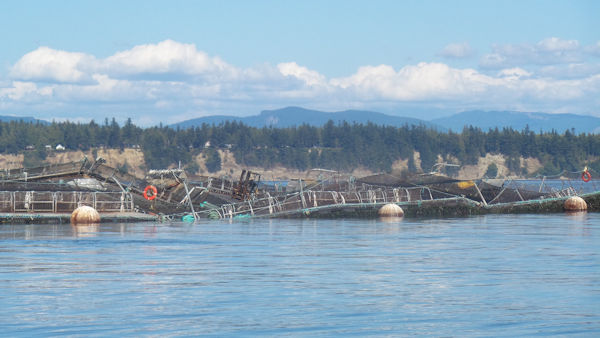SEJournal Online is the digital news magazine of the Society of Environmental Journalists. Learn more about SEJournal Online, including submission, subscription and advertising information.
 |
| Efforts to make aquaculture more sustainable have proven problematic. Above, a collapsed net pen near Cypress Island, Washington, in 2017 released some 250,000 non-native Atlantic salmon into Puget Sound. Photo: Washington DNR (CC BY-NC-ND 2.0). |
Inside Story: ‘Big Fish’ Report Hooks Prize With Look at Aquaculture and Environment
Can seafood be sustainably farmed as Earth’s population mid-century nears 10 billion? That was the question a team of reporters from Hakai Magazine sought to explore. And explore it they did, so well that judges for the Society of Environmental Journalists’ 20th Annual Awards for Reporting on the Environment graced them with a second-place prize in the awards contest’s small-market explanatory category for what they called “an interesting, detailed, knowledgeable look inside the aquaculture industry [that] raises crucial environmental issues and the way those challenges could be met.”
SEJournal Online recently caught up via email with Jude Isabella and Brian Payton about their project, "Big Fish: The Aquacultural Revolution,” which also involved Brendan Borrell, Paul Tullis and Jess Mackie. Here is the conversation.
SEJournal: How did you get your winning story idea?
Jude Isabella: Frustration. When the average person thinks of aquaculture — at least in North America — they automatically think salmon farming. But salmon farming is just a fraction of the aquaculture industry globally. I wanted to give a broader view of how we were domesticating marine animal species.
Brian Payton: My editor suggested it!
SEJournal: What was the biggest challenge in reporting the pieces and how did you solve that challenge?
Isabella: COVID hit and one story, which had lagged behind the others, was caught in the crossfire. The writer couldn't travel. But it all worked out: He hired an on-the-ground reporter to do the shoe-leather work in Myanmar.
Payton: Getting people to focus on the otherwise uninteresting subject of commercial fish feed in a novel way. I looked at the potential of upcycling our domestic food waste to return it to the food system and get readers to question the logic of feeding wildlife to livestock.
SEJournal: What most surprised you about your findings?
Isabella: How there are entrepreneurs trying to find a high-end fish that could compete with salmon but be more sustainable. It's not easy work. And I'm not so sure it's possible. I was also surprised by how salmon aquaculture has driven a lot of technical innovation. The other surprise was the importance of freshwater fish aquaculture to a very large part of the world.
‘I find it amazing the lengths
people will go to continue
‘business as usual’ in their diet.’
— Brian Payton
Payton: The resistance people had to the idea of stopping the farming (and mass consumption) of fish altogether in favor of more sustainable food sources. I find it amazing the lengths people will go to continue "business as usual" in their diet even if it involves fishing for wild fish to feed captive fish to feed people who live thousands of miles from the sea.
SEJournal: How did you decide to tell the series and why?
Isabella: We're interested in long-form, it's one of the things we do best, so we looked for narratives that would tell the stories we wanted to tell about aquaculture. We also thought it was important to create a history timeline of aquaculture — it's not new.
Payton: It seems like the "harm reduction" efforts people are pursuing to make commercial fish feed more sustainable is worthwhile on the way to the larger question of switching to more sustainable food sources.
SEJournal: Does the issue covered in your story have disproportional impact on people of low income, or people with a particular ethnic or racial background? What efforts, if any, did you make to include perspectives of people who may feel that journalists have left them out of public conversation over the years?
‘The story has a huge impact on
people who live in southeast Asia,
particularly from the lower-income bracket.’
— Jude Isabella
Isabella: The story, “The Promise of the Little Fishes,” has a huge impact on people who live in southeast Asia, particularly from the lower-income bracket. We hired a local reporter to assist the journalist with telling the story by getting out into the field to talk to owner-operators of small aquaculture businesses and to visit the local market where many of the fish end up.
Payton: As with most issues involving diet and nutrition, having the ability to select organic or fair trade or ethical food sources often comes at a cost. Another article could focus specifically on the cost-savings of replacing farmed fish protein with a plant-based diet. I pursued some of those issues in another article I wrote on the subject.
SEJournal: What would you do differently now, if anything, in reporting or telling the story/series and why?
Isabella: I think we would look for more data visuals to go along with the story.
Payton: I'm happy with the results given the scope of this article and its place in the overall editorial package. I would welcome the chance to write more about the need to move away from a reliance on seafood for non-coastal populations.
SEJournal: What lessons have you learned from your story or project?
Isabella: Well, the lesson we learned from our first editorial package was to scale back our ambition. We did that with this award-winning package and it was fruitful.
Payton: The idea that we can continue to rely on animal protein is deeply entrenched but does not reconcile with the evidence of sustainability. A deep rethink of food, identity and culture is overdue.
SEJournal: What practical advice would you give to other reporters pursuing similar projects, including any specific techniques or tools you used and could tell us more about?
Isabella: I attended a seafood expo which really helped me design “Big Fish.” My suggestion is to look around at conferences where the people studying whatever your interest come together to talk about myriad problems and solutions.
Payton: Question all assumptions. Pose those questions and watch the sparks fly.
SEJournal: Could you characterize the resources that went into producing your prize-winning reporting (estimated costs, i.e., legal, travel or other; or estimated hours spent by the team to produce)? Did you receive any grants or fellowships to support it?
Isabella: This is difficult to answer. We paid for travel to Vancouver, Hawaii, New York City and Washington, D.C. One writer, grounded by COVID, relied on reporting from a local in Myanmar. The writer was supposed to head into the field with a researcher working with small-scale fish farmers there. We received no grants or fellowships. How many hours? Many!
SEJournal: Is there anything else you would like to share about this story or environmental journalism that wasn’t captured above?
Isabella: Editorial packages can be a pain, but they are worth it. They focus in on an issue that sometimes gets short shrift by dribbling out piecemeal over the years. They can also get readers excited to learn something new from a deep dive.
Payton: Be open to story ideas outside your usual interest.
 |
Jude Isabella (pictured, right) is the founding editor of Hakai Magazine, an online publication focused on coastal science and societies. Isabella also writes science books for young readers. Her latest book, “Bringing Back the Wolves” (Kids Can Press), is a 2020 selection for the New York Public Library’s Best Kids Books of the Year.
Brian Payton is the award-winning author of “Shadow of the Bear,” “The Ice Passage” and the national bestselling novel, “The Wind Is Not a River.” His nonfiction has appeared in The New York Times, The Boston Globe and Canadian Geographic. He lives on Vancouver Island, British Columbia.
* From the weekly news magazine SEJournal Online, Vol. 7, No. 23. Content from each new issue of SEJournal Online is available to the public via the SEJournal Online main page. Subscribe to the e-newsletter here. And see past issues of the SEJournal archived here.

















